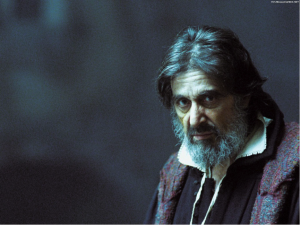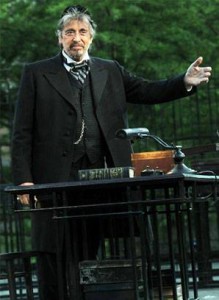Al Pacino portrays Shylock in three different settings in the twenty-first century: once in the film The Merchant of Venice (2004), once through the theatrical program Shakespeare In The Park (2010), and once on Broadway in The Merchant of Venice (2010). While there are many interpretations on the Shylock character from Shakespeare’s The Merchant of Venice, it is less common to have one actor performing the same character in different medias. Pacino’s portrayals of Shylock illuminate not only the complexities of this multifaceted character, but also elaborate on a common Shakespearean controversy; is Shylock a sympathetic character or one imbedded in the anti-semitic culture of Shakespeare’s Venice?
Pacino’s depiction of Shylock in the 2004 film embodies the typical management of the character by film directors post-WWII. The audience sympathizes with Pacino’s Shylock who is bitterly hardened by the constant prejudice he faces. As A. O. Scott writes in his New York Times movie review, “Putting a Still-Vexed Play in Historical Context” (“Putting a Still-Vexed Play in Historical Context”), “Not only is the story punctually announced as taking place in “Venice, 1596” … but introductory titles provide some background about the marginal status and civic oppression of that city’s Jewish population.” However, by placing the setting in context, the film still doesn’t eliminate its anti-semitic influences. In his article “A Very Jewish Villain,” Jonathan Freedland points out: “Crucially, his villainy is not shown as a quirk of his own, individual personality, but is rooted overtly in his Jewishness” (“A Very Jewish Villain“). In essence, Shylock’s villainy cannot be separated from his religious beliefs. One example can be seen when Shylock plans to plot with Tubal against Antonio in their synagogue (3.1.134-135). Why must these plans take place in the synagogue, if not depicting the inherent anti-semitism of the play?
While Pacino’s portrayal of Shylock in this film attempts to eliminate as much anti-semitism as it can, it fails to do so, mostly because of the medium it is performed in. A film by nature allows more control over props, costumes, lighting, cameras, and locations. As seen in the picture above, the dark lighting, rich costume, and looming camera angle give a strong image of Shylock as the villain. In comparison, the picture below, taken of Pacino’s performance as Shylock in Shakespeare in the Park, portrays Shylock surrounded by trees, out in the open. This setting supports Shylock as a character who can represent more than a Jewish caricature.
Al Pacino’s performance of Shylock in the plays of 2010 evolved the debate over Shylock’s character. Returning to the medium in which Shakespeare intended his plays to be performed in, Pacino depicted a complex vision of Shylock. The New York Times article “Railing at a Money-Mad World” by Ben Brantley states:
For as this Shylock rants — and the lines between wrathful avarice and paternal anguish blur beyond reckoning — his state of confusion becomes a heightened mirror of everything around him. As the lights dim on Shylock in limbo, it suddenly hits you that Shakespeare’s vengeance-addled Jew is neither merely the victim nor the villain of this piece; he is instead the very soul of the money-drunk society he serves and despises (“Railing at a Money-Mad World”).
In the outdoor Delacorte Theater in the middle of Central Park, Pacino transformed a character riddled by controversy into something that transcends time, as Shakespeare’s works often do. No longer is Shylock imprisoned by his villainy or lack thereof. Instead, his character highlights how even in modern society, an obsession with money is a result of his money-obsessed society. In this way of performance, Pacino emphasizes even the modern necessity to work toward ridding society of greed.



